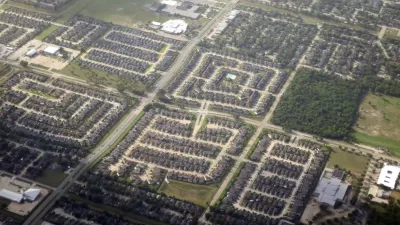Charlie Gardner parses the data on mean commuting times recently released as part of the 2010 ACS estimates for metropolitan statistical areas, and wonders what the maximum mean travel time suggests for the urban form of America's cities.
When comparing the mean commuting times among America's large metro areas, something funny appears. "Although population is strongly correlated with commuting time,
particularly when all metro areas over population one million are
included in the sample, the differences are surprisingly small," notes Gardner. For example, "Orlando, with an urbanized area of only 600 square miles, has a mean
commute just twelve seconds shorter than Dallas, which covers 1,780
square miles, although both cities have comparable densities, employment
centralization and highway miles per capita."
So is there an inherent limit to the potential extent to which development will sprawl into the fringes of a metropolitan area based on a maximum mean commute time of around 30 minutes? Gardner seems to think so and describes how development in, and around Houston, might be shaped by such forces.
"This theory doesn't imply that outwards expansion will come to a
screeching halt once some magical distance from the center is reached," writes Gardner,
"but that the balance of new construction will attempt to shift to the
core as commutes from fringe areas begin to significantly exceed 30
minutes."
Thanks to Daniel Lippman
FULL STORY: Commutes, Tradeoffs and the Limits of Urban Growth

Alabama: Trump Terminates Settlements for Black Communities Harmed By Raw Sewage
Trump deemed the landmark civil rights agreement “illegal DEI and environmental justice policy.”

Planetizen Federal Action Tracker
A weekly monitor of how Trump’s orders and actions are impacting planners and planning in America.

The 120 Year Old Tiny Home Villages That Sheltered San Francisco’s Earthquake Refugees
More than a century ago, San Francisco mobilized to house thousands of residents displaced by the 1906 earthquake. Could their strategy offer a model for the present?

In Both Crashes and Crime, Public Transportation is Far Safer than Driving
Contrary to popular assumptions, public transportation has far lower crash and crime rates than automobile travel. For safer communities, improve and encourage transit travel.

Report: Zoning Reforms Should Complement Nashville’s Ambitious Transit Plan
Without reform, restrictive zoning codes will limit the impact of the city’s planned transit expansion and could exclude some of the residents who depend on transit the most.

Judge Orders Release of Frozen IRA, IIJA Funding
The decision is a victory for environmental groups who charged that freezing funds for critical infrastructure and disaster response programs caused “real and irreparable harm” to communities.
Urban Design for Planners 1: Software Tools
This six-course series explores essential urban design concepts using open source software and equips planners with the tools they need to participate fully in the urban design process.
Planning for Universal Design
Learn the tools for implementing Universal Design in planning regulations.
Clanton & Associates, Inc.
Jessamine County Fiscal Court
Institute for Housing and Urban Development Studies (IHS)
City of Grandview
Harvard GSD Executive Education
Toledo-Lucas County Plan Commissions
Salt Lake City
NYU Wagner Graduate School of Public Service





























